Effective hand function is essential for everyday life. Following a stroke, many survivors experience reduced fine motor skills, hand strength, and/or sensation. Fortunately, researchers have developed various types of hand exercise equipment for stroke patients to help survivors regain functional use of their hands.
While the hand exercise equipment recommendations below are a great place to start, an occupational therapist can also be an excellent resource to consult regarding which hand exercise equipment may be most appropriate for an individual’s specific needs. Depending on which hand functions have been affected and the severity of impairment, certain types of hand exercise equipment for stroke patients may be more effective than others.
This article will begin with an overview of common hand impairments experienced after stroke. Next, some of the best types of hand exercise equipment for stroke patients will be introduced. The importance of practicing hand exercises will also be included.
Please use the links below to jump directly to any section of this article.
- Hand function after stroke
- The most effective hand exercise equipment
- Practical considerations
- Importance of hand exercises for stroke recovery
Hand Function After Stroke
A stroke occurs when there is a lack of blood flow to the brain, causing damage to affected areas. Depending on which areas of the brain have been affected, survivors may experience physical, cognitive, and/or emotional secondary effects.
Various areas of the brain are associated with hand functions, including:
- Primary motor cortex: directs movements
- Somatosensory cortex: receives information regarding sensation
- Cerebellum: fine-tunes movements
- Basal ganglia: assists with coordination
When these areas become damaged by a stroke, survivors may experience changes in their hand functions. Often, only one side of the body is affected, because each hemisphere (side) of the brain controls the opposite side of the body. Therefore, since a stroke is typically localized to one side of the brain, only the hand opposite the brain damage will be affected.
Common conditions that occur secondary to stroke that may affect hand function include:
- Hemiplegia: paralysis on one side of the body
- Hemiparesis: weakness on one side of the body
- Spasticity: involuntary muscle tightness
- Contractures: extreme stiffness of muscles, joints, and/or connective tissues
- Tremors: rhythmic, unintentional shaking
Since every stroke is different, each individual will experience unique secondary effects. Therefore, the best hand exercise equipment for stroke patients may vary depending on one’s specific strengths and needs.
The Best Hand Therapy Equipment for Stroke Patients
Rehabilitation is essential for regaining hand function after stroke. However, finding the best hand exercise equipment for stroke patients can be challenging. Consulting with an occupational therapist can help survivors navigate the many different types of hand therapy equipment available.
Some of the most frequently recommended types of hand exercise equipment are outlined below. This list includes some of Flint Rehab’s own products – because hand therapy is our specialty – but it also includes other tools, with unaffiliated links.
The best hand therapy equipment for stroke patients include:
1. Hand Therapy Balls – Best for Travel
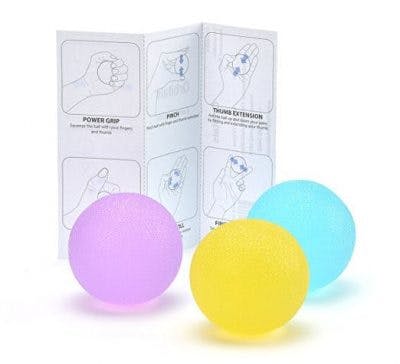
Hand therapy balls offer a simple way to exercise the hands, especially for individuals with severe spasticity and clenched hands. Therapy balls have multiple resistance levels, designed to give survivors with various functional abilities an appropriate challenge.
Most hand therapy ball exercises focus on managing spasticity or increasing strength. Depending on the survivor’s needs, they may use balls of varying resistance for different exercises. For example, a harder ball may be better to roll in the hand for a finger stretch, while a softer ball may be more appropriate to squeeze between the fingers for strengthening.
Shop hand exercise balls on Amazon »
2. Therapy Putty – Most Versatile

Therapy putty is a popular, inexpensive hand therapy tool among many occupational therapists. Similar to hand therapy balls, therapy putty also comes in multiple resistances. Obtaining a putty set with multiple resistances is ideal, since survivors are often able to use a tougher putty as their strength improves.
Therapy putty is among the best hand exercise equipment for stroke patients because of its versatility. While it can be used for traditional hand strengthening exercises, some choose to use therapy putty to practice cutting or to hide pennies in. Many survivors even find themselves mindlessly working with the putty throughout their day to gradually improve their hand strength.
Shop therapy putty on Amazon »
3. Finger Exercisers – Good for Strengthening
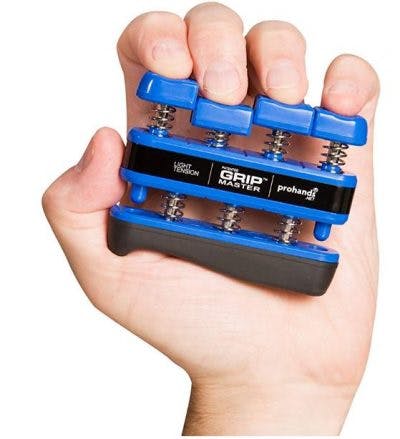
While hand therapy balls and therapy putty can be excellent tools for strengthening the hands, finger and/or grip exercisers can often provide more resistance. In addition to being able to grip the tool with a full hand, finger exercisers also provide a great way to work on isolated strengthening of each finger.
Shop hand exercisers on Amazon »
4. Tabletop Mirror Therapy – Good for Paralysis Recovery
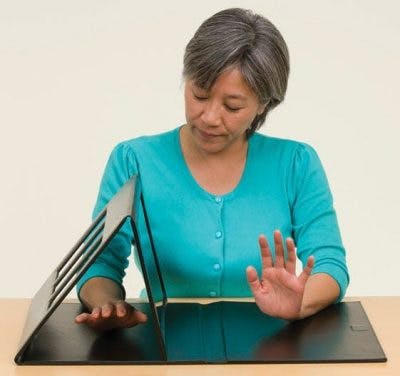
Mirror therapy is a rehabilitation technique that can help improve hand paralysis after stroke. It involves using a tabletop mirror to reflect the movement of one’s unaffected hand, while hiding the affected hand from view. Watching the reflection of the unaffected hand moving in the mirror can help survivors better visualize their affected hand moving, encouraging recovery.
After practicing mirror therapy in the clinic setting with an occupational therapist, survivors may choose to continue the therapy at home. While it is possible to make a mirror box using a mirror, double sided tape, and a box, professionally made mirror therapy sets are also available.
Shop mirror therapy sets on Amazon »
5. PVC Pipe Tree – Good for Coordination
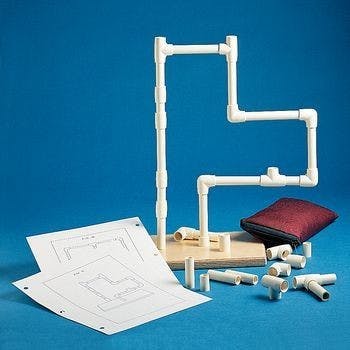
Pipe trees are among the best hand exercise equipment for stroke patients because they allow survivors to practice coordinating both fine and gross motor skills. Along with addressing the ability to grasp and release objects, the pipe tree also requires fine motor precision and upper arm movement. Furthermore, following a pattern to create the “tree” can also address cognitive skills.
6. MusicGlove – Good for Fast Results
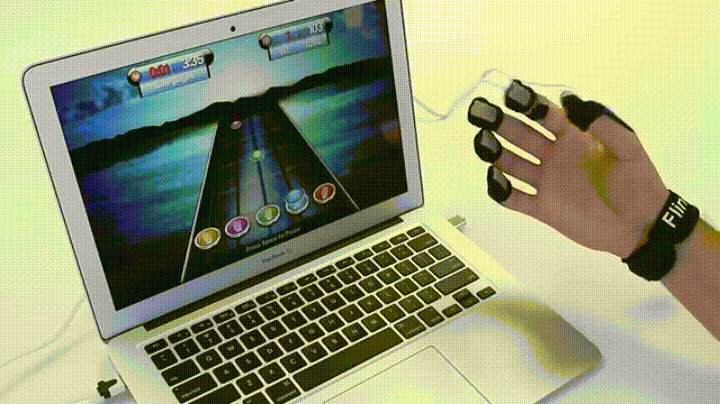
MusicGlove is a premium music- and gaming-based hand therapy device made by Flint Rehab that has been clinically proven to improve hand function in two weeks. This high-tech hand exercise equipment encourages survivors to perform numerous therapeutic hand exercises in rhythm with the music.
Unlike other hand exercise equipment, MusicGlove is something that survivors want to use daily because it is fun to use. Consistent practice is essential for recovery, making the MusicGlove an effective form of hand therapy.
Shop MusicGlove from Flint Rehab »
7. FitMi Home Therapy – Good for Paralysis Recovery

FitMi is another high-tech exercise tool from Flint Rehab that motivates survivors to exercise the entire body, including the hands. It uses a gamified approach to rehabilitation, and adapts to the survivor’s skill level to provide just the right level of challenge. FitMi is suitable for all ability levels, even for survivors without any active hand movement.
Practical Considerations
While many different types of hand exercise equipment have been developed, it can be challenging to determine which tools are best for a specific individual. The best hand exercise equipment for stroke patients should be:
- Accessible: survivors must be able to obtain the equipment to use it
- Engaging: tools must be motivating in order to encourage frequent use
- Appropriately challenging: tools that are too easy or too difficult to use are not effective for promoting recovery
Occupational therapists can provide excellent recommendations of conventional therapy tools, such as those listed above, that meet these qualities. However, not all individuals may be able to afford to purchase conventional therapy tools. In this case, in order to make the equipment accessible, an occupational therapist may also be able to recommend ways to use everyday objects to help improve hand function. Some examples of this include:
- Using clothespins to pick up cotton balls to address fine motor strength and precision
- Improving coordination and grasp and release skills by building a structure out of Legos
- Feeling different textured objects, such as a fleece blanket, sheet, or washcloth, as part of a sensory re-education program
With this in mind, sometimes the best hand exercise equipment for stroke patients may not be conventional therapy equipment at all. This is because the way the equipment is used is just as important, if not more so, than having a specific tool.
How to Use Hand Exercise Equipment for Recovery
In order to recover from stroke, individuals must consistently and repetitively practice exercises and activities involving affected functions. This is because massed practice stimulates adaptive brain rewiring.
When a task is practiced frequently, the brain perceives that the task is important. Using a process called neuroplasticity, the brain is able to rewire itself to create and strengthen neural pathways to make that task easier to perform. When the task involves functions that have been affected by stroke, control of the affected functions can be rewired to healthy areas of the brain.
This helps to explains why the best hand exercise equipment for stroke patients can vary person to person. The most effective tools are those that are used consistently to address affected functions. Some individuals may be more motivated to practice using high-tech devices, while others may be more likely to practice consistently with a hand therapy ball that can be used on the go.
Therefore, when considering which type of hand exercise equipment is best, it is important for survivors to think about which types of equipment will be most motivating to use on a regular basis. Consistent practice is essential to achieve an optimal recovery.
Understanding Hand Exercise Equipment for Stroke Patients
A stroke can affect one’s hand strength, movement, coordination, and sensation. Using hand exercise equipment is a great way that survivors can regain these functions.
The best hand exercise equipment for stroke patients varies by the individual and their needs. However, regardless of the type of equipment, it is essential for survivors to be consistently practicing exercises and activities involving their affected functions. This stimulates adaptive rewiring in the brain to help survivors achieve an optimal recovery.
The post The Best Hand Exercise Equipment for Stroke Patients appeared first on Flint Rehab.



